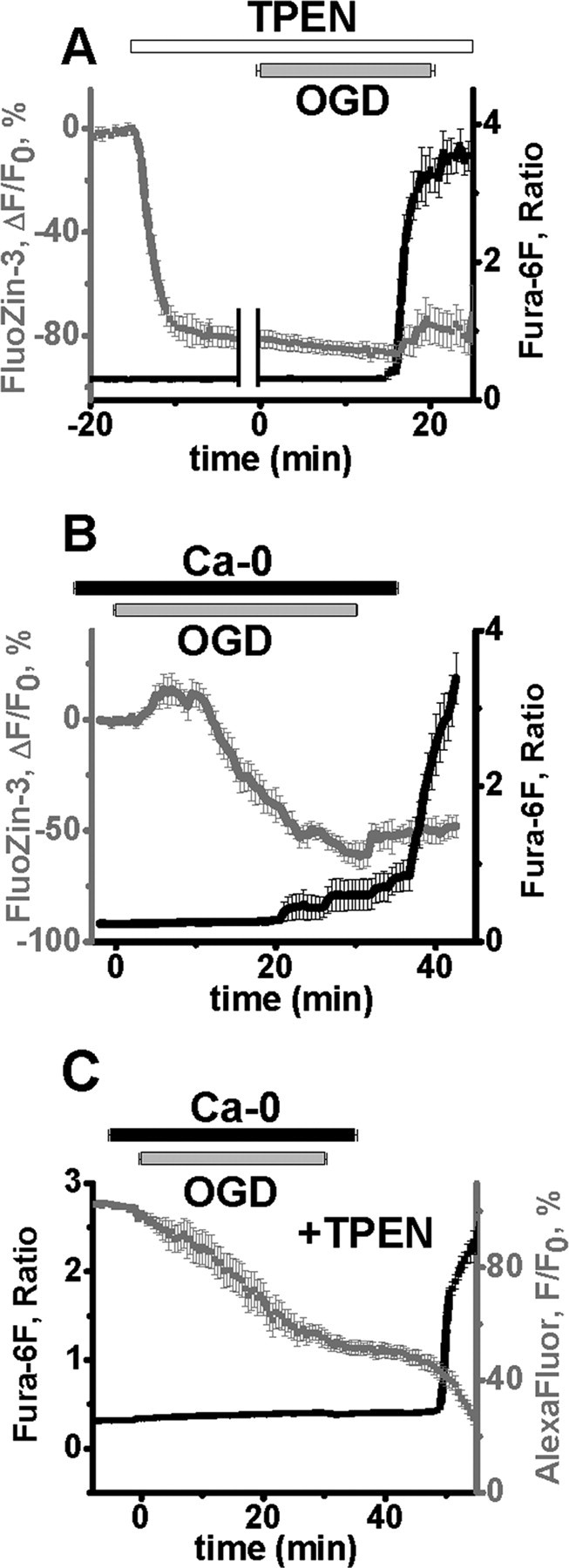Figure 4.

Ca2+ and Zn2+ both are involved in triggering of OGD evoked Ca2+ deregulation. A, Bath application of TPEN effectively chelates intraneuronal Zn2+ and significantly delays OGD-evoked Ca2+ deregulation. Neurons were coloaded with FluoZin-3 and fura-6F, and exposed to TPEN (40 μm) for 15 min before and during OGD. TPEN decreased basal FluoZin-3 fluorescence by 80 ± 3.2% within 10 min of application (gray), without affecting the fura-6F 340/380 nm ratio (black) (left side of panel; traces aligned to the addition of TPEN). Subsequent OGD exposures evoked Ca2+ deregulation (as indicated by a sharp fura-6F ratio increase), which was significantly delayed (n = 6, 16.0 ± 0.91 vs 10.27 ± 0.32 min in control, n = 9), but greatly reduced changes in FluoZin-3 fluorescence (which remained well below basal fluorescence) (right side of panel; traces aligned to onset of Ca2+ deregulation). All data (±SEM) are obtained from the same 6 CA1 neurons. B, OGD-induced Zn2+ rises still occur despite removal of extracellular Ca2+. Neurons were coloaded with FluoZin-3 and fura-6F and slices superfused with Ca2+-free ACSF for 5 min before, during and for 5 min after a 30 min episode of OGD. During prolonged OGD in Ca2+-free ACSF, Zn2+ rises still occurred after 5–10 min (as in the presence of Ca2+) (Fig. 3). However, under these conditions the peak FluoZin-3 fluorescence increase seemed to be blunted, followed by a slow decrease in fluorescence due to enhanced cell swelling which occurred during OGD exposures in Ca2+-free ACSF. The Ca2+ deregulation occurred shortly after replacement of Ca2+, and was unaccompanied by major changes in the FluoZin-3 fluorescence. Traces show mean values ± SEM. C, TPEN significantly delays the Ca2+ deregulation after prolonged OGD in Ca2+-free ACSF. CA1 neurons were subjected to OGD in nominally Ca2+-free ACSF as in Figure 2A, but in the presence of TPEN (40 μm). Under these conditions the Ca2+ deregulation and associated abrupt loss of AlexaFluor-488 fluorescence still occurred, but were markedly delayed (14.2 ± 1.5 min after Ca2+ replacement, p < 0.001 vs no TPEN condition; n = 7 cells, ±SEM).
